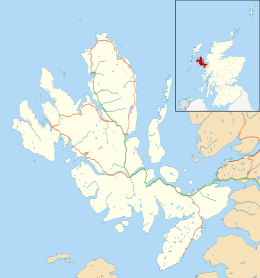Dun Beag
Dun Beag is an iron-age broch located about 1 kilometre northwest of the village of Struan on the west coast of the island of Skye, in Scotland.
Dun Beag | |
 Dun Beag shown within the Isle of Skye, Scotland | |
| Location | Skye |
|---|---|
| Coordinates | 57.360355°N 6.425767°W |
| Type | Broch |
| History | |
| Periods | Iron Age |
| Site notes | |
| Ownership | Historic Scotland |
| Public access | Yes |
Description
Dun Beag (grid reference NG339386) is situated at the north end of a small rocky knoll.[1] The broch consists of a drystone tower with a diameter of around 18.6 metres with walls about 4 metres thick at the base.[1] The broch currently stands to a maximum height of 2 metres.[2]
The interior has a diameter of about 11 metres, and the entrance is on the east side.[2] Internally three openings are visible in the broch wall.[2] One leads to a small chamber; a second leads to a long narrow gallery within the wall; and a third leads to the stone stair of which some twenty steps survive.[2]
History
The broch was visited by Thomas Pennant in 1772, and it was still a substantial structure, with a height of perhaps 4 metres.[1] The following year a broch near Ullinish, which was probably Dun Beag, was visited by Samuel Johnson and James Boswell during their Tour to the Hebrides.[1] Around half of its wall height has been lost since the 18th century.[1]
The broch was excavated by the Countess Vincent Baillet de Latour between 1914 and 1920.[1] Some 200 tons of earth and stones were removed from the broch and all the soil was sifted through the excavators' fingers.[1] The standard of recording and publication was poor.[1] Finds included many stone implements and utensils, a gold ring, bronze objects, a piece of folded sheet lead, iron and glass objects, a borer of bone, a pick made from an antler, much pottery and a stone cup.[1] Several hundred glass beads were found although they are not thought to be prehistoric.[1] Coins of Henry II, Edward I, James VI, George II and George III have been discovered, and it is possible that the broch was in use until comparatively recently.[1]
References
- Historic Environment Scotland. "Skye, Dun Beag (11062)". Canmore. Retrieved 13 February 2014.
- "Dun Beag". Historic Scotland. Retrieved 13 February 2014.